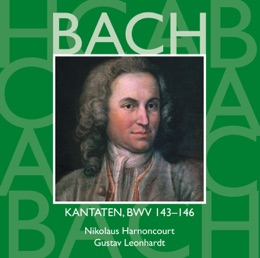Ich lebe, mein Herze, zu deinem Ergötzen, BWV 145
I live, my heart, to your delight ( BWV 145) is a church cantata by Johann Sebastian Bach. He wrote it in Leipzig for the third Ostertag and led them probably on April 19, 1729 for the first time.
History and words
The prescribed readings for the feast were Acts 13.26-33 LUT, the preaching of Paul at Antioch, and Luke 24.36-49 LUT, the appearance of Jesus with the disciples in Jerusalem after his resurrection. The cantata is handed down only in a later copy. Five of the seven movements based on a text published in the Picander his cantata cycle of 1728, so a first performance on April 19, 1729 seems likely. Picander went in his text does not elaborate on the readings. The transcript also contains the beginning, a hymn stanza, Caspar Neumann's chorale " In my heart, the Lord's Day " ( 1700 ) and the first sentence of a cantata by Georg Philipp Telemann, "So you confess with your mouth Jesus ", a paraphrase of Romans 10.9 LUT. The beginning of the Telemann set is title of the copy. The two sets were added after Bach's death and make the cantata for the Easter Sunday suitable. After Klaus Hofmann Carl Philipp Emanuel Bach expanded the cantata in his Hamburg period (after 1768) and set the initial chorale itself by Christoph Wolff, the cantata may have been compiled by Carl Friedrich Zelter for the Berlin Sing- Akademie. The final chorale is the 14th and last stanza of Nicholas Herman Easter song " Released is the glorious day."
Scoring and structure
The cantata is staffed with three soloists, soprano, tenor and bass, four-part choir, trumpet, Flauto traverso, two oboe d'amore, two violins, viola and basso continuo.
Music
The first additional sentence is a four-part chorale verse set. The set of Telemann 's two-piece, playing a duet and a choral fugue in the strings and woodwinds with the voices colla parte, while the trumpet is partially performed independently. In Telemann's work was preceded by an instrumental introduction on the subject.
The music on Picander text begins in Theorem 3 in a duet with violin obbligato. The tenor conveys the position of Jesus: "I live, my heart, to your delight ," while the soprano responds as a believer: " You live, my Jesus, to my delight ." The set is similar duets from Bach's secular cantatas and is perhaps the parody of an unknown plant. It is unusual that Bach tenor can sing the words of Jesus. The following secco recitative ends as arioso to emphasize: "My heart, keep this in mind! ", A thought takes the following bass aria. In this aria accompany all instruments except the viola, she has character of dance with regular periods and is perhaps also a parody of a secular work. The cantata will be decided by a four -part setting of the Easter hymn " Released is the glorious day."
Recordings
- J. S. Bach: The cantatas - Sacred Cantatas Vol 6, Nikolaus Harnoncourt, Tölz Boys Choir, Concentus Musicus Wien, soloist of the Tölz Boys Choir, Kurt Equiluz, Thomas Hampson, Teldec 1983
- The Bach Cantata Vol 23, Helmuth Rilling, Gächinger Kantorei, Bach-Collegium Stuttgart, Costanza Cuccaro, Adalbert Kraus, Andreas Schmidt, Haenssler 1984
- Bach Edition Vol 12 - Cantatas Vol 6, Pieter Jan Leusink, Holland Boys Choir, Netherlands Bach Collegium, Ruth Holton, Nico van der Meel, Bas Ramselaar, Brilliant Classics 1999
- J. S. Bach: Cantatas for the 3rd Sunday of Epiphany, John Eliot Gardiner, Monteverdi Choir, English Baroque Soloists, Angharad Gruffydd Jones, James Gilchrist, Stephen Varcoe, Soli Deo Gloria 2000
- J. S. Bach: Complete Cantatas Vol 12, Ton Koopman, Amsterdam Baroque Orchestra & Choir, Johan Zomer, Christoph Prégardien, Klaus Mertens, Antoine Marchand 2000
- J. S. Bach: Cantatas Vol 32 - BWV 111, 123, 124, 125, Masaaki Suzuki, Bach Collegium Japan, Hana Blažíková, Gerd Türk, Peter Kooij UNTIL 2011










